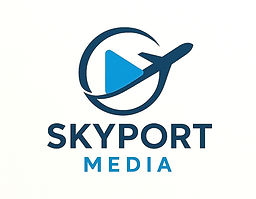Unlocking Airline Success: The Power of Video Encoding Services
- ed8331
- Aug 1
- 4 min read
In today's fast-paced world, airlines are constantly seeking ways to enhance their services and improve customer satisfaction. One powerful tool that has emerged in recent years is video encoding services. These services can transform how airlines communicate with their passengers, market their offerings, and manage their operations.
Video encoding is the process of converting video files into a format that can be easily streamed or downloaded. This technology is not just for entertainment; it has practical applications that can significantly benefit airlines. In this blog post, we will explore how video encoding services can unlock success for airlines, improve customer engagement, and streamline operations.
The Importance of Video in the Airline Industry
Video content has become a dominant form of communication. According to recent studies, consumers are more likely to engage with video content than any other type of media. For airlines, this means that incorporating video into their marketing and customer service strategies can lead to better engagement and higher conversion rates.
Airlines can use video to showcase their services, highlight destinations, and provide valuable information to passengers. Whether it is a promotional video for a new route or an instructional video on how to navigate the airport, video can make a significant impact.
Enhancing Customer Experience with Video
One of the most significant advantages of video encoding services is the ability to enhance the customer experience. Airlines can use video to provide passengers with essential information before, during, and after their flights.
For example, airlines can create pre-flight videos that explain the check-in process, security procedures, and boarding protocols. This can help reduce anxiety for first-time travelers and make the process smoother for everyone.
During the flight, airlines can offer in-flight entertainment options that include movies, TV shows, and documentaries. By encoding these videos for easy access, airlines can keep passengers entertained and engaged throughout their journey.
After the flight, airlines can use video to gather feedback from passengers. Short video surveys can provide valuable insights into customer satisfaction and areas for improvement.
Marketing and Promotion through Video
Video encoding services can also play a crucial role in marketing and promotion. Airlines can create visually appealing promotional videos that highlight their unique offerings.
For instance, a video showcasing a new luxury lounge can entice travelers to choose that airline over competitors. Similarly, destination videos can inspire potential travelers to book flights to exciting locations.
Social media platforms are ideal for sharing these videos. Airlines can reach a broader audience by posting engaging video content on platforms like Instagram, Facebook, and YouTube. This not only increases brand visibility but also encourages user interaction and sharing.
Streamlining Operations with Video
Beyond customer engagement and marketing, video encoding services can help airlines streamline their operations. Training videos for staff can ensure that employees are well-prepared to handle various situations, from customer service to safety protocols.
For example, airlines can create training videos for cabin crew that cover emergency procedures, customer service best practices, and new equipment usage. This can lead to more efficient operations and a safer environment for both staff and passengers.
Additionally, video can be used for internal communication. Airlines can share important updates, policy changes, and company news through video messages. This can foster a sense of community and keep employees informed and engaged.
The Role of Technology in Video Encoding
The success of video encoding services relies heavily on technology. With advancements in encoding software and hardware, airlines can produce high-quality videos that are optimized for various platforms.
Cloud-based encoding services allow airlines to store and access their video content easily. This means that videos can be updated and distributed quickly, ensuring that passengers always have access to the latest information.
Moreover, adaptive bitrate streaming technology ensures that videos play smoothly on different devices and internet connections. This is crucial for airlines, as passengers may access video content on smartphones, tablets, or laptops while traveling.
Case Studies: Airlines Leveraging Video Encoding Services
Several airlines have successfully implemented video encoding services to enhance their operations and customer experience.
Example 1: Delta Air Lines
Delta Air Lines has embraced video content to improve customer engagement. They produce high-quality promotional videos that showcase their services and destinations. These videos are shared across social media platforms, increasing brand awareness and attracting new customers.
Example 2: Emirates
Emirates Airlines uses video encoding to enhance the in-flight experience. They offer a wide range of movies and TV shows that passengers can access through their personal screens. This not only keeps passengers entertained but also sets Emirates apart from competitors.
Example 3: Southwest Airlines
Southwest Airlines has utilized video for internal training purposes. They create engaging training videos for their staff, ensuring that employees are well-prepared to provide excellent customer service. This has led to improved employee performance and customer satisfaction.
Challenges and Considerations
While video encoding services offer numerous benefits, airlines must also consider potential challenges.
Quality Control
Ensuring high-quality video content is essential. Poorly produced videos can reflect negatively on the airline's brand. Airlines should invest in professional video production and encoding services to maintain quality.
Accessibility
Airlines must ensure that their video content is accessible to all passengers, including those with disabilities. This may involve providing subtitles or audio descriptions for videos.
Data Management
With the increasing amount of video content, airlines need to have a robust data management system in place. This includes organizing, storing, and retrieving video files efficiently.
The Future of Video in the Airline Industry
As technology continues to evolve, the role of video in the airline industry will only grow. Airlines that embrace video encoding services will be better positioned to meet the needs of their customers and stay ahead of the competition.
Emerging technologies, such as virtual reality (VR) and augmented reality (AR), may also play a role in the future of airline video content. Imagine passengers being able to take a virtual tour of their destination before they even arrive.
Final Thoughts
The power of video encoding services cannot be underestimated in the airline industry. By leveraging video content, airlines can enhance customer experience, improve marketing efforts, and streamline operations.
As the industry continues to evolve, those who embrace video technology will unlock new opportunities for success. Airlines that invest in high-quality video content will not only engage their passengers but also create lasting impressions that drive loyalty and growth.

In a world where attention spans are short and competition is fierce, video encoding services offer airlines a unique way to stand out and connect with their audience. The future is bright for those who harness the power of video.



Comments